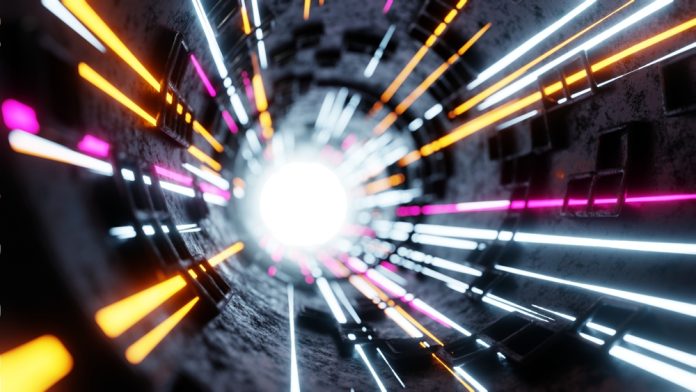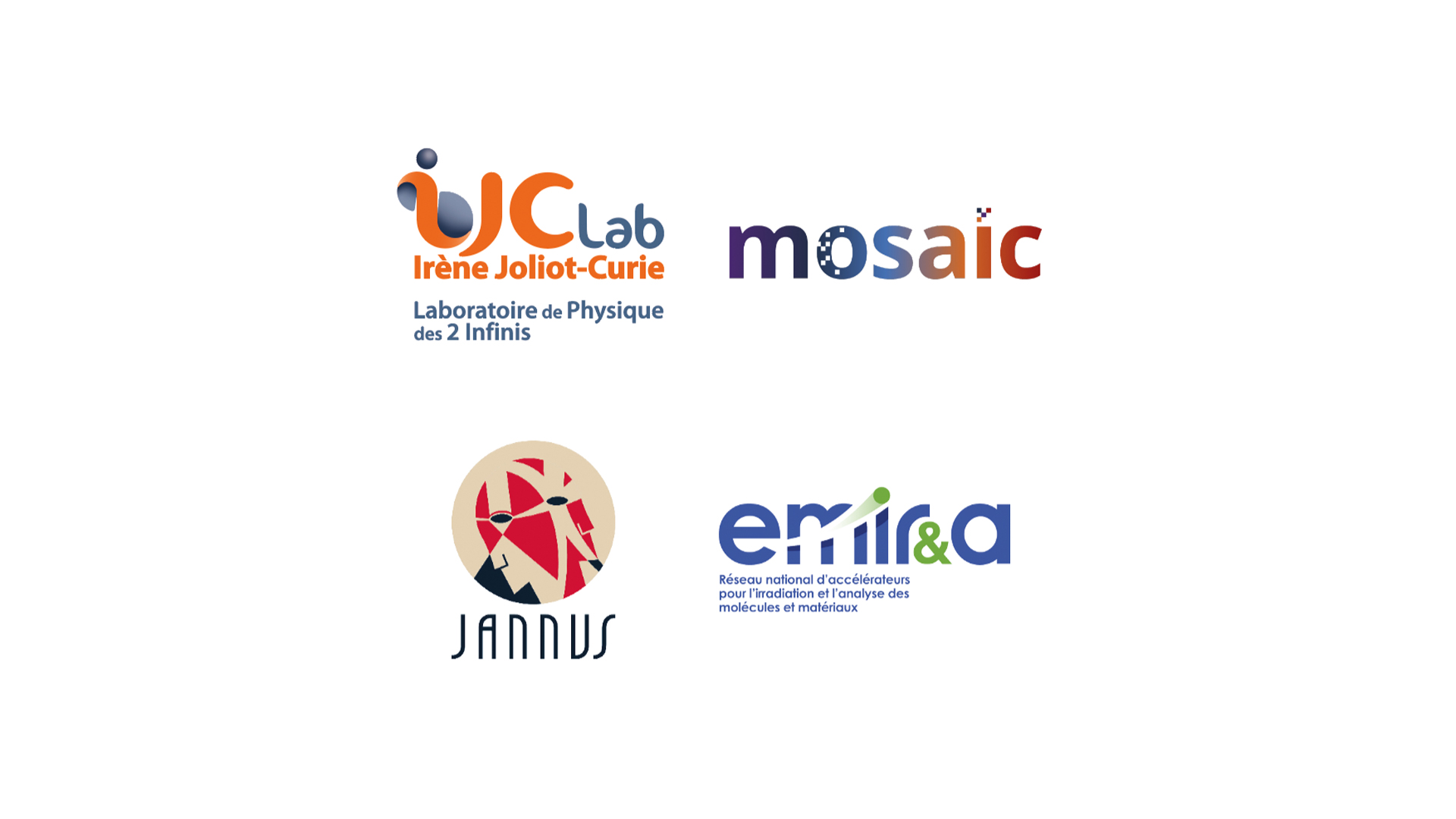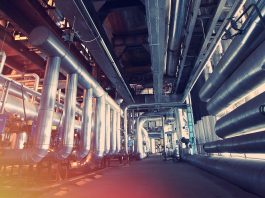The MOSAIC platform at IJCLab in France combines various ion beam equipment into a unique facility for state-of-the-art R&D in ion beam modification, structural and chemical analysis of materials.
The MOSAIC¹ platform is located in two buildings at the Orsay valley campus and is one of the platforms under the leadership of IJCLab (Laboratoire de Physique des 2 Infinis – Irène Joliot-Curie), a research lab supported by Université Paris-Saclay and CNRS (National Centre for Scientific Research, IN2P3 Institute). MOSAIC is labelled as an IN2P3² platform.
A diverse range of scientific fields
MOSAIC is an interdisciplinary research platform open to numerous scientific fields: Materials science, astrochemistry, nuclear astrophysics, nuclear physics, geology, biology, and environmental sciences, to name a few. Applications cover fields as vast as: Nuclear energy (fusion/fission) and renewable energy, micro- and nano-electronics, medical isotope production, materials for accelerators and detectors, space applications, etc.
The MOSAIC platform combines various ion beam facilities (a 4 MV Andromede Pelletron, a 2 MV ARAMIS electrostatic ion accelerator, a 190 kV IRMA ion implanter, and a 40 kV SIDONIE isotope separator) into a unique, multi-purpose facility, mainly used for ion beam modification of materials (implantation/irradiation/synthesis/deposit), and structural and chemical analysis using a variety of techniques (RBS, ERDA, PIXE, PIGE ion beam analysis techniques, and microscopies). The facility also hosts capability to perform spectrometry (an MSI Mass Spectrometry Imaging), and advanced multi-scale microstructure characterization with transmission electron microscopy (TEM), scanning electron microscopy (SEM), and atomic force microscopy (AFM) instruments.
In support of these experiments, the facility is equipped with dedicated experimental tools for sample preparation especially for thin foils relevant for in situ irradiations and TEM studies (cutting, polishing, carbon deposition).

The facility benefits from years of technical and scientific expertise in operating numerous accelerators coupled to dedicated precision end-stations. A key MOSAIC speciality is its ability to provide Aunq+ nanoclusters and ion beams from most of the stable elements in the periodic table (from proton to bismuth) over a wide energy range from 50 eV to 32 MeV. Such diverse beams can be provided for end-station sample temperatures ranging from -170°C to 1000°C.
World-class facilities
The MOSAIC facility offers several experimental capabilities:
- Ion deposition on substrates, and ion implantation and irradiation of solids, with a wide energy range, a large variety of light and heavy ions and gold nanoparticles are available, over an exceptionally wide temperature range,
- In situ observation and analysis at the nanoscale enables studying the evolution of the materials’ microstructure under single/dual ion irradiation, using in situ dual ion beam Transmission Electron Microscopy, with with added capabilities of EELS and EDX,
- Ion beam analysis of materials to obtain an elemental distribution versus depth with RBS channeling, ERDA, PIXE techniques, including in situ RBS-C with ion implantation,
- High-energy nanoparticle beam as a powerful probe for surface analysis by time-of-flight secondary ion mass spectrometry (ToF-SIMS) in various types of solids: Atomic and molecular imaging with nanometric resolution in situ, surface analysis impact-by-impact with high-yield secondary ion emission (multiplicity, angular distribution, correlation of secondary ions),
- Hosting experimental facilities (international collaboration) for the study of reactions at very low nuclear energies: E.g. STELLA (led by IPHC) to reproduce and study nuclear reactions in massive stars to resolve stellar nucleosynthesis mechanisms; or NewJEDI (GANIL) for the existence of light dark bosons,
- Surface and topography analysis of materials using Scanning Electron Microscopy and Atomic Force Microscopy.
One of the specialities of the platform is the in situ techniques available that are world-renowned for materials structure and chemical characterisation (i.e. in situ Rutherford Backscattering Spectrometry in Channelling geometry (RBS-C), in situ Transmission Electron Microscopy (TEM) with single/dual ion beam irradiation), and mass spectrometry imaging (MSI).
The isotope separator SIDONIE is one of the few in Europe that can still produce high-purity isotopes. Owing to its age (built in the late sixties), an upgrade is ongoing.

source is available on Sidonie, IRMA and Némée. ARAMIS is equipped with a positive Penning ion source located at the voltage terminal and an
external Cs sputtering source (SNICS). Andromède uses an electron cyclotron resonance (ECR) source or a liquid metal ion source (LMIS) in the
high-voltage terminal of the electrostatic accelerator
Widespread applications in research and industry
The ion beams of the MOSAIC facility are used for highly interdisciplinary research within several research groups at IJCLab, such as materials for nuclear energy, nuclear physics and interdisciplinary studies for surface analysis, radioisotopes production for health, nuclear astrophysics, astrochemistry, and materials for detectors and accelerators. MOSAIC also welcome students for internships and lab work for Master studies at the Université Paris-Saclay. The facility has been offering its facilities and services to users from industry and academic research in French and foreign Universities and organisations for more than 40 years.
The Andromede NEC Pelletron accelerator was acquired in the framework of Equipex funding (2011-2020) of the French government. IRMA ion implanter and ARAMIS ion accelerator were home-built in the late seventies and eighties, respectively.
A Transmission Electron Microscope was connected to 190 kV IRMA in the early eighties, updated in 1994, and a second beamline coming from the ARAMIS accelerator was connected to a 200 kV LaB6 FEI Tecnai TEM in 2007.
Since 2005, the JANNuS-Orsay experimental hall (bringing together the ARAMIS accelerator, IRMA implanter, the associated beamlines and the in situ TEM) has been closely linked to the triple ion beam JANNuS-Saclay facility at CEA Saclay (French Alternative Energies and Atomic Energy Commission), France, through the JANNuS Scientific Interest Group (GIS).³
In 2009, JANNuS was a founding member of the EMIR&A⁴ French network of accelerators for irradiation and analysis of molecules and materials (now a Research Infrastructure in France). It combines 15 complimentary electron and ion accelerators and in situ instruments installed at 11 platforms distributed over six sites in France.
Beam time is available each year through the EMIR&A call for proposals to users worldwide, and in particular for the MOSAIC platform at Andromede for ToF-SIMS experiments using MeV gold nanoparticles and at JANNuS-Orsay for the in situ TEM connected to one or/and two ion beams.
It is worth noting that developments and upgrades are continuously made to keep the facility at the state-of-the-art level. As an example, the 30 kV test bench Tancrede, built in the 2000s to deliver intense beams of multi-charged atomic and molecular ions with a 10 GHz ECR ion source, is being re-installed and optimised. The upgrades will enable ion manipulation and trapping techniques and to measure ionic desorption yields of materials of interest for high energy particle accelerators.
Another ongoing project is the construction of a new ion beam line at the ARAMIS 2 MV ion accelerator to be connected to an advanced high-performance X-ray diffractometer. This will allow in situ structural characterisation of solids as a function of the ion irradiation, from hundred keV to few MeV light and heavy ions – to our knowledge, such a unique capability is otherwise not duplicated anywhere else in the world.
Particularly, the results from experiments using MOSAIC will be of great importance for research on materials under irradiation (elastic deformation, point defects, phase changes, basic understanding of ion-solid interactions, …) and especially for nuclear materials.
References
1. https://mosaic.ijclab.in2p3.fr
2. IN2P3 stands for Institute of Nuclear Physics and Particle Physics (https://www.in2p3.cnrs.fr). It is one of the Institutes of the National Center for Scientific Research (CNRS).
3. https://jannus.in2p3.fr/
4. https://emira.in2p3.fr/
Please note, this article will also appear in the 19th edition of our quarterly publication.





